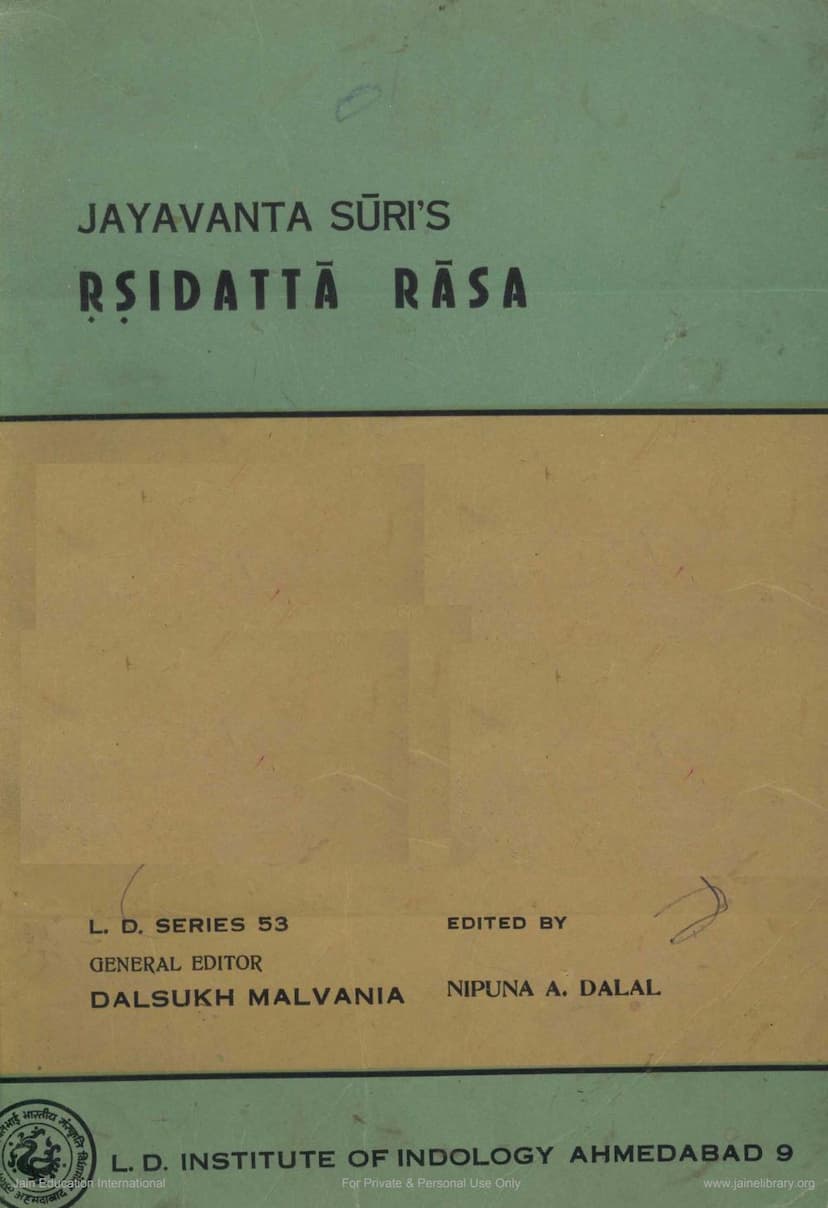Rushidattras
Added to library: September 2, 2025

Summary
This document is an edited version of "Rushidattras" by Jayvantasuri, published by L. D. Institute of Indology, Ahmedabad, in 1975. The book is part of the L. D. Series, edited by Nipuna A. Dalal and with Dal Sukh Malvania as the general editor. The publication was supported by the Government of India, Ministry of Education and Social Welfare.
The "Rushidattras" is a narrative poem in Gujarati, likely composed around the period of 1614-1652 AD, based on manuscripts dating from 1659 AD and 1665 AD. The text is praised for its use of old Gujarati language, offering insights into the language of that era. The editor, Dr. Nipuna Dalal, is commended for her meticulous work in compiling different manuscript variations and providing a detailed introduction to Jayvantasuri and his works.
The story of Rushidatta itself originates from the 13th century and is found in the commentary of "Aakhyanakmanikosh." The popularity of this story is evident from the numerous adaptations, including poems and narrative songs, that followed. The text centers on the life of a chaste woman, Rushidatta, who maintains her integrity and reputation despite facing numerous hardships. The editor also notes the changes and variations introduced by different authors over time, and includes a collection of proverbs, descriptions, and a glossary in the appendices.
Key aspects of Jayvantasuri and his works, as detailed in the text:
- Jayvantasuri: He was an important poet of medieval Gujarati literature, belonging to the Vradatpaga Chh, established by Acharya Vinayamanasuri. His literary output spans from around 1614 to 1652 AD. He was a celibate ascetic. His works showcase a strong command of Sanskrit and familiarity with rhetorical principles. He often mentions his guru, Vinayamanadan Upadhyay, in his writings.
- Jayvantasuri's Gurus and lineage: The text traces his lineage through his guru, Vinayamanadan Upadhyay, who also had another disciple, Vivekdhirganni, skilled in architecture. The guru-parampara tree is presented, showing Vijaydharmasuri as the originator.
- Jayvantasuri's Works: Besides "Rushidatta Rasa," he authored several other works, including:
- "Shrungarmanjari" (also known as "Shilavati Charitra") - 1614 AD.
- "Sthulabhadrakosha Premvilas Phag" - around 1614 AD.
- "Nemarajul Baramas Velprabandh."
- "Simandhar Swami Lekh."
- "Rajulagitani."
- "Sthulabhadra Mohanveli."
- "Simandhar Chandrula."
- "Git Sangrah" (a collection of 53 devotional songs).
- "Lochan-Kajal Samvad."
- "Nemnath Stavana."
- A commentary on "Kavyaprakash."
- "Rushidatta Rasa" - Content and Structure:
- The poem has 41 stanzas (dhal) and is composed in the "Ras" literary form.
- The story revolves around the love triangle involving Prince Kankarattha, Rushidatta (daughter of the ascetic Harisena), and Princess Rukmini.
- It depicts themes of love, chastity, betrayal, hardship, and ultimately, spiritual attainment.
- The narrative involves mystical elements like invisibility (through an elixir) and divine intervention.
- Jayvantasuri criticizes polygamy, highlighting the woman's suffering in such situations.
- The poem is rich in descriptions of nature, festivals, and societal customs.
- It showcases various emotions like love, sorrow, anger, and devotion, contributing to different "rasas" (aesthetic moods).
- The conclusion emphasizes the importance of karma, detachment from worldly pleasures, and the path to salvation through righteous conduct and spiritual practice.
- The "Ras" Literary Form: The text discusses the "Ras" as a significant literary genre in ancient Gujarati literature, characterized by poetic verses (duhas, chaupais, or dashi) in rhyming prose, often narrative or biographical in nature. It served as a medium for religious instruction and cultural information. The evolution of the "Ras" from a simple lyrical form to a descriptive narrative is also noted, with "Bharaesvar Bahubali Ras" (1241 AD) being the oldest known example.
- Influence and Variations: The text highlights the influence of earlier works on Jayvantasuri's "Rushidatta Rasa" and notes variations in details across different manuscripts and authors, suggesting the story's enduring popularity and adaptation over time.
- Social and Cultural Context: The narrative offers glimpses into medieval Indian society, including the role of royalty, ascetics, social festivities, prevailing beliefs in omens, magic, and the consequences of karma and one's actions. It also touches upon the justice system and punishments prevalent at the time.
- Linguistic Features: The language is identified as old Gujarati with a significant Sanskrit influence. It also shows traces of other regional languages, demonstrating linguistic evolution. The text details various grammatical features, phonetic usages, and the use of different literary devices like metaphors, similes, and personification.
In essence, "Rushidattras" by Jayvantasuri, as presented in this edited volume, is a valuable contribution to Gujarati literature, offering a blend of devotional narrative, ethical teachings, and linguistic insights into medieval India.